Policy Recommendations for Reducing Food Waste: An Analysis Based on a Survey of Urban and Rural Household Food Waste in Harbin, China
Abstract
1. Introduction
2. Materials and Methods
2.1. Data and Information for Estimating FW Trends in Harbin
2.2. Survey of Daily Lifestyles and FW Generation
2.2.1. Sampling Size and Analytical Approach
2.2.2. Content of Questionnaire
2.3. Methodology
2.3.1. Logistic Regression Model
2.3.2. t-Test
2.3.3. Analysis of Variance (ANOVA)
3. Results
3.1. Trends in FW Generation in Harbin
3.2. Results of the Survey
3.2.1. Attributes of the Respondents
3.2.2. Lifestyle and Dietary Habits of Urban and Rural Residents
3.2.3. Food Waste Situations and Reasons
3.2.4. Respondents’ Attitudes toward Food Waste Reduction
3.3. National and Local Policies Related to Food Waste
4. Discussion and Recommendations
4.1. Differences in Characteristics between Urban and Rural Residents
4.2. Differences in Dietary Habits between Urban and Rural Residents
4.3. Differences in Food Waste between Urban and Rural Residents
4.4. Differences in Attitudes toward Reducing Food Waste and Sorting Kitchen Waste between Urban and Rural Residents
4.5. Recommendations
5. Conclusions
Author Contributions
Funding
Institutional Review Board Statement
Informed Consent Statement
Data Availability Statement
Acknowledgments
Conflicts of Interest
References
- Ozkaya, F.T.; Durak, M.G.; Dogan, O.; Bulut, Z.A.; Haas, R. Sustainable consumption of food: Framing the concept through Turkish expert opinions. Sustainability 2021, 13, 3946. [Google Scholar] [CrossRef]
- FAO. The State of Food Security and Nutrition in the World 2022: Repurposing Food and Agricultural Policies to Make Healthy Diets More Affordable; Food and Agriculture Organization: Rome, Italy, 2022; Available online: https://reliefweb.int/report/world/state-food-security-and-nutrition-world-2022-repurposing-food-and-agricultural-policies-make-healthy-diets-more-affordable-enarruzh?gclid=Cj0KCQjwxYOiBhC9ARIsANiEIfays924V7bFGt3J5fwRzfFPQhB2Ef_oVpkONfSvSlWz3LxUi1N7Ff8aAuHuEALw_wcB (accessed on 20 April 2023).
- FAO. The State of Food Security and Nutrition in the World 2019; Food and Agriculture Organization: Rome, Italy, 2019; Available online: https://www.wfp.org/publications/2019-state-food-security-and-nutrition-world-sofi-safeguarding-against-economic (accessed on 20 April 2023).
- Zhang, M.; Chen, S.; Li, S. Life Cycle-Based Case Study of Greenhouse Gas Emissions and Emission Reduction from Food Consumption in Beijing Flavor Restaurants. Adv. Clim. Chang. Res. 2021, 17, 140–150. [Google Scholar]
- UNEP Food Waste Index Report 2021. United Nations Environment Programme. 2021. Available online: https://www.unep.org/resources/report/unep-food-waste-index-report-2021 (accessed on 4 April 2023).
- Ritchie, H.; Food Waste Is Responsible for 6% of Global Greenhouse Gas Emissions. Our Wold in Data 2020. Available online: https://ourworldindata.org/food-waste-emissions (accessed on 3 April 2023).
- FAO. The State of Food and Agriculture 2019; Food and Agriculture Organization: Rome, Italy, 2019; Available online: https://www.fao.org/3/ca6030en/ca6030en.pdf (accessed on 21 April 2023).
- FAO. Food Wastage Footprint: Impacts on Natural Resources; Food and Agriculture Organization: Rome, Italy, 2013; Available online: http://www.fao.org/3/a-i2697e.pdf (accessed on 21 April 2023).
- Schneider, F. Review of food waste prevention on an international level. Waste Resour. Manag. 2013, 166, 187–203. [Google Scholar] [CrossRef]
- Lipinski, B. Reducing Food Loss and Waste. World Resources Institute. 2013. Available online: https://www.wri.org/publication/reducing-food-loss-and-waste (accessed on 21 April 2023).
- Feng, Y.; Marek, C.; Tosun, J. Fighting Food Waste by Law: Making Sense of the Chinese Approach. J. Consum. Policy 2022, 45, 457–479. [Google Scholar] [CrossRef]
- Chen, C. EU Anti-Food Waste Practice Experience and Insights. World Agric. 2022, 12, 24–33. [Google Scholar]
- Shen, Y.Z.; Niu, K.Y.; Song, R.; Liu, J.; Zhu, T.; Weng, L.P. Anti-food waste policies on the ground: International experience and local practice. Agric. Resour. Zoning China 2023, 44, 119–129. [Google Scholar]
- Werf, P.; Seabrook, J.A.; Gilliland, J.A. The quantity of food waste in the garbage stream of southern Ontario, Canada households. PLoS ONE 2018, 13, e0198470. [Google Scholar]
- Adelodun, B.; Kim, S.H.; Choi, K.S. Assessment of food waste generation and composition among Korean households using novel sampling and statistical approaches. Waste Manag. 2021, 12, 72–80. [Google Scholar] [CrossRef]
- Everitt, H.; Werf, P.; Seabrook, J.A.; Wray, A.; Gilliland, J.A. The quantity and composition of household food waste during the COVID-19 pandemic: A direct measurement study in Canada. Socio-Econ. Plan. Sci. 2022, 82, 101110. [Google Scholar] [CrossRef]
- Ilakovac, B.; Voca, N.; Pezo, L.; Cerjak, M. Quantification and determination of household food waste and its relation to sociodemographic characteristics in Croatia. Waste Manag. 2020, 102, 231–240. [Google Scholar] [CrossRef]
- Withanage, S.V.; Dias, G.M.; Habib, K. Review of household food waste quantification methods: Focus on composition analysis. J. Clean. Prod. 2021, 279, 123722. [Google Scholar] [CrossRef]
- Moult, J.A.; Allan, S.R.; Hewitt, C.N.; Berners-Lee, M. Greenhouse gas emissions of food waste disposal options for UK retailers. Food Policy 2018, 77, 50–58. [Google Scholar] [CrossRef]
- Sarker, A.; Ghosh, M.K.; Islam, T.; Bilal, M.; Nandi, R.; Raihan, M.L.; Hossain, M.N.; Rana, J.; Barman, S.K.; Kim, J.E. Sustainable Food Waste Recycling for the Circular Economy in Developing Countries, with Special Reference to Bangladesh. Sustainability 2022, 14, 12035. [Google Scholar] [CrossRef]
- Zhu, M.X.; Luo, Y.; Huang, H.Q.; Huang, D.; Wu, L.P. Characteristics, environmental impacts and countermeasures of food waste in Chinese rural households. Agric. Mod. Res. 2022, 43, 948–956. [Google Scholar]
- Shahbaz, P.; Ul Haq, S.; Abbas, A.; Samie, A.; Boz, I.; Bagadeem, S.; Yu, Z.; Li, Z. Food, Energy, and Water Nexus at Household Level: Do Sustainable Household Consumption Practices Promote Cleaner Environment? Int. J. Environ. Res. Public Health 2022, 9, 12945. [Google Scholar] [CrossRef] [PubMed]
- Schanes, K.; Dobernig, K.; Gözet, B. Food waste matters-A systematic review of household food waste practices and their policy implications. J. Clean. Prod. 2018, 182, 978–991. [Google Scholar] [CrossRef]
- Ananda, J.; Karunasena, G.G.; Mitsis, A.; Kansal, M.; Pearson, D. Analysing behavioural and socio-demographic factors and practices influencing Australian household food waste. J. Clean. Prod. 2021, 306, 127280. [Google Scholar] [CrossRef]
- Nakamura, K.; Kojima, D.; Ando, M. What reduces household food waste in Japan? Nation-Wide and region-specific contributing factors in urban and rural areas. Sustainability 2022, 14, 3174. [Google Scholar] [CrossRef]
- Li, Y.; Wang, L.E.; Liu, G.; Cheng, S. Rural household food waste characteristics and driving factors in China. Resour. Conserv. Recycl. 2021, 164, 105209. [Google Scholar] [CrossRef]
- Haas, R.; Aşan, H.; Doğan, O.; Michalek, C.R.; Karaca Akkan, Ö.; Bulut, Z.A. Designing and Implementing the MySusCof App—A Mobile App to Support Food Waste Reduction. Foods 2022, 11, 2222. [Google Scholar] [CrossRef]
- Hanson, V.; Ahmadi, L. Mobile applications to reduce food waste within Canada: A review. Can. Geogr. Le Géographe Can. 2022, 66, 402–411. [Google Scholar] [CrossRef]
- GP. A Review of Low-Carbon Management for the Whole Life Cycle of Kitchen Waste. Greenpeace International 2021. Available online: https://www.greenpeace.org.cn/2021/07/19/kitchen-waste-life-cycle-management-report-pr-20210716/ (accessed on 22 April 2023).
- WWF Report on Food Waste in Urban Catering in China. World Wide Fund for Nature 2018. Available online: https://www.wwfchina.org/news-detail?id=1810&type=3 (accessed on 22 April 2023).
- Jiang, J.Q.; Yu, T.E.; Huang, W.Z.; Wang, Z. Size estimation and determinants analysis of household food waste in China. Agric. Technol. Econ. 2018, 9, 88–99. [Google Scholar]
- Qian, L.; Rao, Q.L.; Li, F. Food waste of rural residents and its influencing factors—Taking staple food waste as an example. J. Jiangnan Univ. 2021, 20, 47–57. [Google Scholar]
- HLPE Food Losses and Waste in the Context of Sustainable Food Systems; Food and Agriculture Organization: Rome, Italy, 2014. Available online: http://iufost.org/iufostftp/FLW-%20FAO.pdf (accessed on 23 April 2023).
- Luo, Y.; Wang, H.R.; Miao, H.M.; Huang, D.; Han, Y.; Zhu, J.F. Obesity and food waste in Chinese rural households: An empirical analysis based on survey data from 1562 farm households. J. Nat. Resour. 2022, 37, 2559–2571. [Google Scholar]
- WRAP Household Food and Drink Waste in the United Kingdom 2012. Waste and Resources Action Programme 2012. Available online: https://wrap.org.uk/resources/report/household-food-and-drink-waste-united-kingdom-2012 (accessed on 24 April 2023).
- Sun, G.H. Harbin City waste treatment and disposal status and management. Heilongjiang Sci. Technol. Inf. 2016, 10, 298. [Google Scholar]
- Xuan, L.L.; Ma, D.Y. The problem of urban domestic waste and its management: Harbin City as an example. J. Harbin Univ. Commer. 2014, 1, 89. [Google Scholar]
- Liu, C.; Cai, X.M.; Bunditsakulchaib, P.; Sasakic, S.; Hotta, Y. Food waste in Bangkok: Current situation, trends and key challenges. Resour. Conserv. Recycl. 2020, 157, 104779. [Google Scholar] [CrossRef]
- Kish, L. Survey Sampling. Biom. J. 1965, 10, 88–89. [Google Scholar]
- Li, L.M. Study on the method of sample size allocation under stratified sampling. Stat. Decis. Mak. 2015, 19, 18–20. [Google Scholar]
- Jackson, J.; Murphy, P. Clusters in Regional Tourism an Australian case. Ann. Tour. Res. 2006, 33, 1018–1035. [Google Scholar] [CrossRef]
- Li, M.L.; Qiu, H.L.; Xu, H.Q.; Shu, B.Y. Comparison of the impact of online sample base surveys and telephone surveys on research results. Stat. Decis. Mak. 2019, 35, 14–19. [Google Scholar]
- Verhulst, P.F. Mathematical Researches into the Law of Population Growth Increase. New Mem. R. Acad. Sci. Fine Lett. Bruss. 1945, 18, 1–42. [Google Scholar]
- Fisher Box, J. Guinness, Gosset, Fisher, and Small Samples. Stat. Sci. 1987, 2, 45–52. [Google Scholar]
- Liu, H.Y. Applied Psychostatistics; Beijing Normal University Press: Beijing, China, 2015; pp. 172–173. [Google Scholar]
- Edwards, A.W.F. RA Fisher, Statistical Methods for Research Workers, 1925. In Landmark Writings in Western Mathematics: Case Studies; Elsevier Science: Amsterdam, The Netherlands, 2005; pp. 1640–1940. [Google Scholar]
- Liu, J. Application of Single factor Analysis of Variance. Prose Hundred 2016, 6, 150. [Google Scholar]
- Heilongjiang Daily News. 120 Tons of Kitchen Waste, How Much Food Is Wasted Every Day in Harbin. Available online: https://hlj.sina.cn/news/haerbin/2020-08-17/detail-iivhuipn9033818.d.html?pos=347 (accessed on 29 April 2023).
- Harbin Bureau of Statistics. Harbin Statistical Yearbook 2021. Available online: http://www.harbin.gov.cn/art/2023/4/4/art_39_1372063.html (accessed on 29 April 2023).
- National Bureau of Statistics. Statistical Yearbook 2022. Available online: http://www.stats.gov.cn/sj/ndsj/2022/indexch.htm (accessed on 30 April 2023).
- Harbin Municipal People’s Government Website. Announcement of Harbin Municipal Administration for Market Regulation on Collecting Clues of Violations in “Anti-Food Waste Special Action”. Available online: http://www.harbin.gov.cn/art/2023/4/25/art_4955_1377762.html (accessed on 30 April 2023).
- People’s Government of Heilongjiang Province Website. Three Departments in Harbin City Issued a Call to Action to Reduce Food Waste in the Catering Industry. Available online: https://www.hlj.gov.cn/hlj/c107858/202304/c00_31574949.shtml (accessed on 30 April 2023).
- The Labor Contract Law of the People’s Republic of China. Household Annual Income Level Classification. Available online: https://lvlin.baidu.com/question/992867107635866379.html (accessed on 3 May 2023).
- Zhu, L.L. Classified Citizenship of Agricultural Transferred Population in the Urbanization Process of Harbin City. Shanxi Agric. Econ. 2017, 12, 15. [Google Scholar]
- Shimpo, M.; Akamatsu, R.; Kojima, Y.; Yokoyama, T.; Okuhara, T.; Chiba, T. Factors Associated with Dietary Change since the Outbreak of COVID-19 in Japan. Nutrients 2021, 13, 2039. [Google Scholar] [CrossRef]
- Peking University Legal Information Platform. The General Office of the Communist Party of China Central Committee and the General Office of the State Council Issued the “Opinions on Practicing Frugality and Opposing Food Waste”. Available online: https://www.pkulaw.com/chl/93e666fb03f5e10bbdfb.html (accessed on 5 May 2023).
- Peking University Legal Information Platform. People′s Republic of China Anti-Food Waste Law. Available online: https://www.pkulaw.com/chl/97d7d0ae995676c1bdfb.html (accessed on 5 May 2023).
- Northeast Network. Implementation Plan for Practicing Thrift and Opposing Food Waste in Heilongjiang Province. Available online: https://heilongjiang.dbw.cn/system/2014/07/15/055855012.shtml (accessed on 5 May 2023).
- Harbin Municipal People’s Government Website. Harbin Urban Kitchen Waste Management Measures. Available online: http://www.harbin.gov.cn/art/2019/8/21/art_727_775632.html (accessed on 5 May 2023).
- Harbin Municipal People’s Government Website. The Harbin Market Supervision Bureau Has Fully Deployed a Special Campaign to Curb Food Waste in the Catering Industry. Available online: http://xxgk.harbin.gov.cn/art/2023/3/27/art_13135_1372168.html (accessed on 5 May 2023).
- Li, L.L.; Qiao, D.; Cheng, H. “Operation CD-ROM”, continuous promotion. People′s Dly. 2022, 1. [Google Scholar] [CrossRef]
- People’s Network. In Response to the Central Government’s Call, a New Wave of “Operation Clean Plate” Has Been Launched Everywhere. Available online: https://baike.baidu.com/reference/4306554/363dvp6Ak1dJdFBwYvq2fnCo-4ut1KiFWHzaAF6fYbdiCylOo90xyeD-0CN4WxZOk89Dd0cYS0RaTdWBsBjbvareSWcWvKUByS4427LsqqBRNp46YdmvX9Rtmw (accessed on 7 May 2023).
- Liao, F. A study of the factors influencing food waste behavior based on an extended MOA mode. J. Shanxi Agric. Univ. 2022, 21, 99–108. [Google Scholar]
- Wu, Y.; Tian, X.; Li, X.; Yuan, H.; Liu, G. Characteristics, influencing factors, and environmental effects of plate waste at university canteens in Beijing, China. Resources Conserv. Recycl. 2019, 149, 151–159. [Google Scholar] [CrossRef]
- Schneider, F. Wasting Food—An Insistent Behavior. Research Gate 2008. Available online: https://www.researchgate.net/publication/237566848_Wasting_food-An_insistent_behaviour (accessed on 7 May 2023).
- Zhang, H.; Duan, H.; Andric, J.M.; Song, M.; Yang, B. Characterization of household food waste and strategies for its reduction: A Shenzhen City case study. Waste Manag. 2018, 78, 426–433. [Google Scholar] [CrossRef]
- Ganglbauer, E.; Fitzpatrick, G.; Comber, R. Negotiating food waste: Using a practice lens to inform design. Negot. Food Waste 2013, 20, 11. [Google Scholar] [CrossRef]
- Stancu, V.; Haugaard, P.; Lhteenmki, L. Determinants of consumer food waste behaviour: Two routes to food waste. Appetite 2016, 96, 7–17. [Google Scholar] [CrossRef] [PubMed]
- Abdelradi, F. Food waste behaviour at the household level:A conceptual framework. Waste Manag. 2018, 71, 485–493. [Google Scholar] [CrossRef]
- Aschemann-Witzel, J.; Giménez, A.; Ares, G. Household food waste in an emerging country and the reasons why: Consumer’ s own accounts and how it differs for target groups. Resour. Conserv. Recycl. 2019, 145, 332–338. [Google Scholar] [CrossRef]
- Van, S.J.G.; Woodburn, M.J. Food discard practices of householders. J. Am. Diet. Assoc. 1987, 87, 322–329. [Google Scholar]
- Quested, T.E.; Marsh, E.; Stunell, D.; Parry, A.D. Spaghetti soup: The complex world of food waste behaviors. Resour. Conserv. Recycl. 2013, 79, 43–51. [Google Scholar] [CrossRef]
- Porpino, G.; Wansink, B.; Parente, J. Wasted Positive Intentions: The Role of Affection and Abundance on Household Food Waste. J. Food Prod. Mark. 2015, 22, 733–751. [Google Scholar] [CrossRef]
- Richter, B.; Bokelmann, W. Explorative study about the analysis of storing, purchasing and wasting food by using household diaries. Resour. Conserv. Recycl. 2017, 125, 181–187. [Google Scholar] [CrossRef]
- Zepeda, L.; Balaine, L. Consumers′ perceptions of food waste: A pilot study of U.S. students. Int. J. Consum. Stud. 2017, 41, 627–637. [Google Scholar] [CrossRef]
- Carmo, S.; Dutra, D. Drivers and barriers to food waste reduction. Br. Food J. 2018, 120, 2364–2387. [Google Scholar]
- Wang, L.E.; Liu, G.; Liu, X.; Liu, Y.; Gao, J.; Zhou, B.; Gao, S.; Cheng, S. The weight of unfinished plate: A survey-based-characterization of restaurant food waste in Chinese cities. Waste Manag. 2017, 66, 3–12. [Google Scholar] [CrossRef] [PubMed]
- Zhang, P.P.; Wang, L.; Bai, J.; Liu, X.; Cheng, S.; Fu, S. A study on food waste behavior of restaurant consumers in tourist cities. Resour. Sci. 2018, 40, 1186–1195. [Google Scholar]
- Ludovica, P. Towards Zero Waste: An Exploratory Study on Restaurant managers. Int. J. Hosp. Manag. 2018, 74, 130–137. [Google Scholar]
- Song, L.; Yang, J.X.; Tong, D.J.; Wen, J.W. A study on the level of food waste and its influencing factors in catering takeaway—Taking school students in Anhui Province as an example. Arid Zone Resour. Environ. 2022, 36, 113–119. [Google Scholar]
- Mattar, L.; Abiad, M.G.; Chalak, A.; Diab, M.; Hassan, H. Attitudes and behaviors shaping household food waste generation: Lessons from Lebanon. J. Clean. Prod. 2018, 198, 1219–1223. [Google Scholar] [CrossRef]
- Zhu, Q.; Li, F.; Qian, Z. A study on the waste profile of canteen food and its takeaway carbon footprint in Chinese universities and colleges: A survey based on 9660 questionnaires from 30 universities and colleges in 30 provinces (cities). Arid Zone Resour. Environ. 2020, 34, 49–55. [Google Scholar]
- Qiu, Z.Q.; Meng, B.W.; Lin, Y.X.; Chen, S. A study on the current situation of separating and disposing of take-out leftover food waste by university students. Mod. Food 2019, 5, 187–191. [Google Scholar]
- Chen, S. Analysis of the current situation of take-out food waste and the influencing factors of college students in higher education. Food Saf. Guide 2018, 33, 50. [Google Scholar]
- Lian, T.; Haq, S.U.; Shahbaz, P.; Zhao, L.; Nadeem, M.; Aziz, B. Changing Food Patterns during the Pandemic: Exploring the Role of Household Dynamics and Income Stabilization Strategies. Sustainability 2023, 15, 123. [Google Scholar] [CrossRef]
- Secondi, L.; Principato, L.; Laureti, T. Household food waste behaviour in EU-27 countries: A multilevel analysis. Food Policy 2015, 56, 25–40. [Google Scholar] [CrossRef]
- Cecere, G.; Mancinelli, S.; Mazzazti, M. Waste Prevention and Social Preferences: The Role of Intrinsic and Extrinsic Motivations. Ecol. Econ. 2014, 10, 163–176. [Google Scholar] [CrossRef]
- Qi, D.; Lai, W.; Roe, B.E. Food waste declined more in rural Chinese households with livestock. Food Policy 2020, 98, 101893. [Google Scholar] [CrossRef]
- Luo, Y.; Huang, D.; Wu, L.P. Household food waste in rural China: A noteworthy reality and a systematic analysis. Waste Manag. Res. 2021, 39, 1389–1395. [Google Scholar] [CrossRef] [PubMed]
- Barr, S.; Gilg, A.W.; Ford, N.J. Difference between household waste reduction, reuse and recycling behaviour: A study of reported behaviors, intentions and explanatory variables. Environment. Waste Manag. 2001, 4, 69–82. [Google Scholar]
- Lober, D.J. Municipal solid waste policy and public participation in household source reduction. Waste Manag. 1996, 14, 125–143. [Google Scholar] [CrossRef]
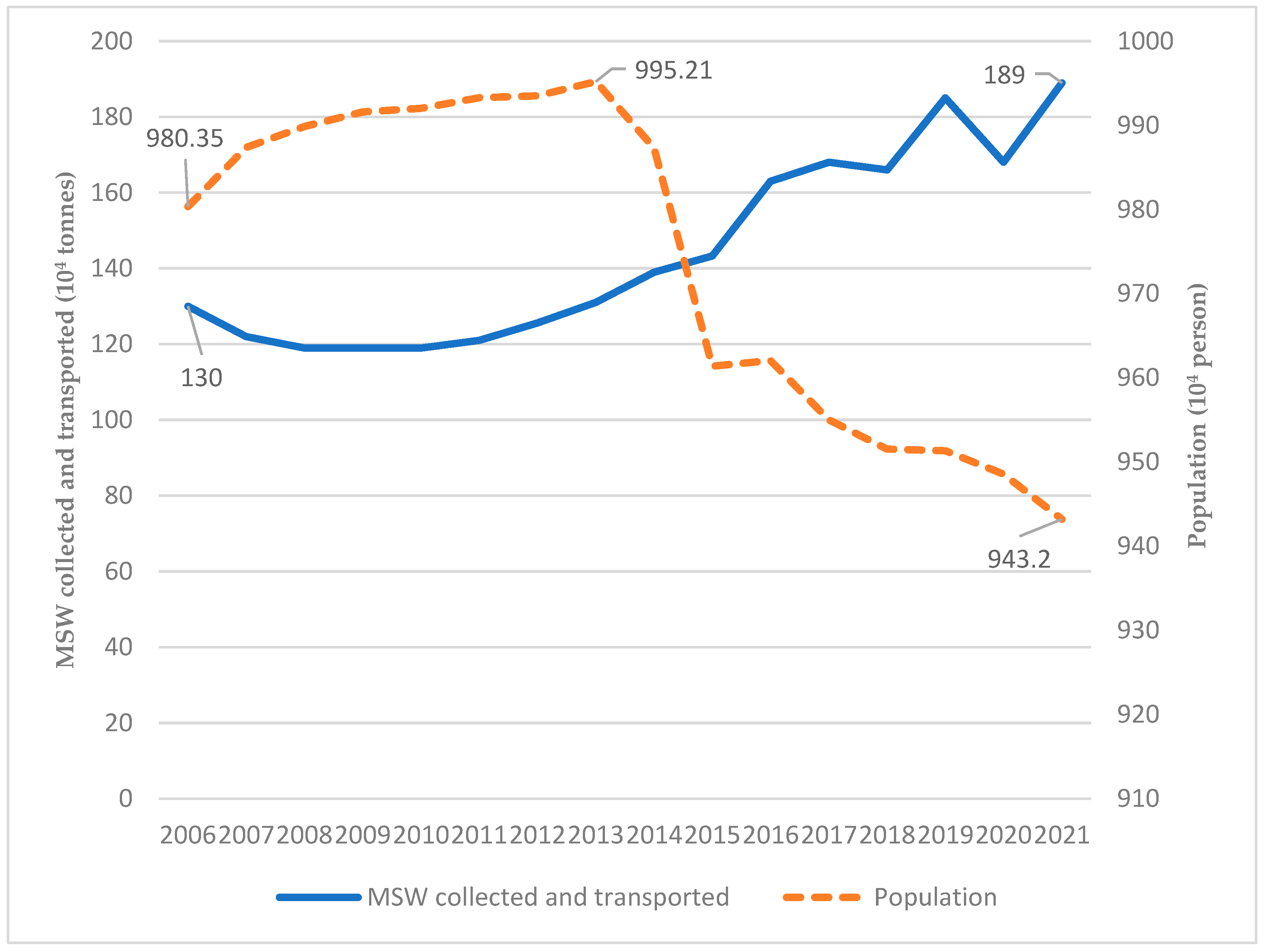
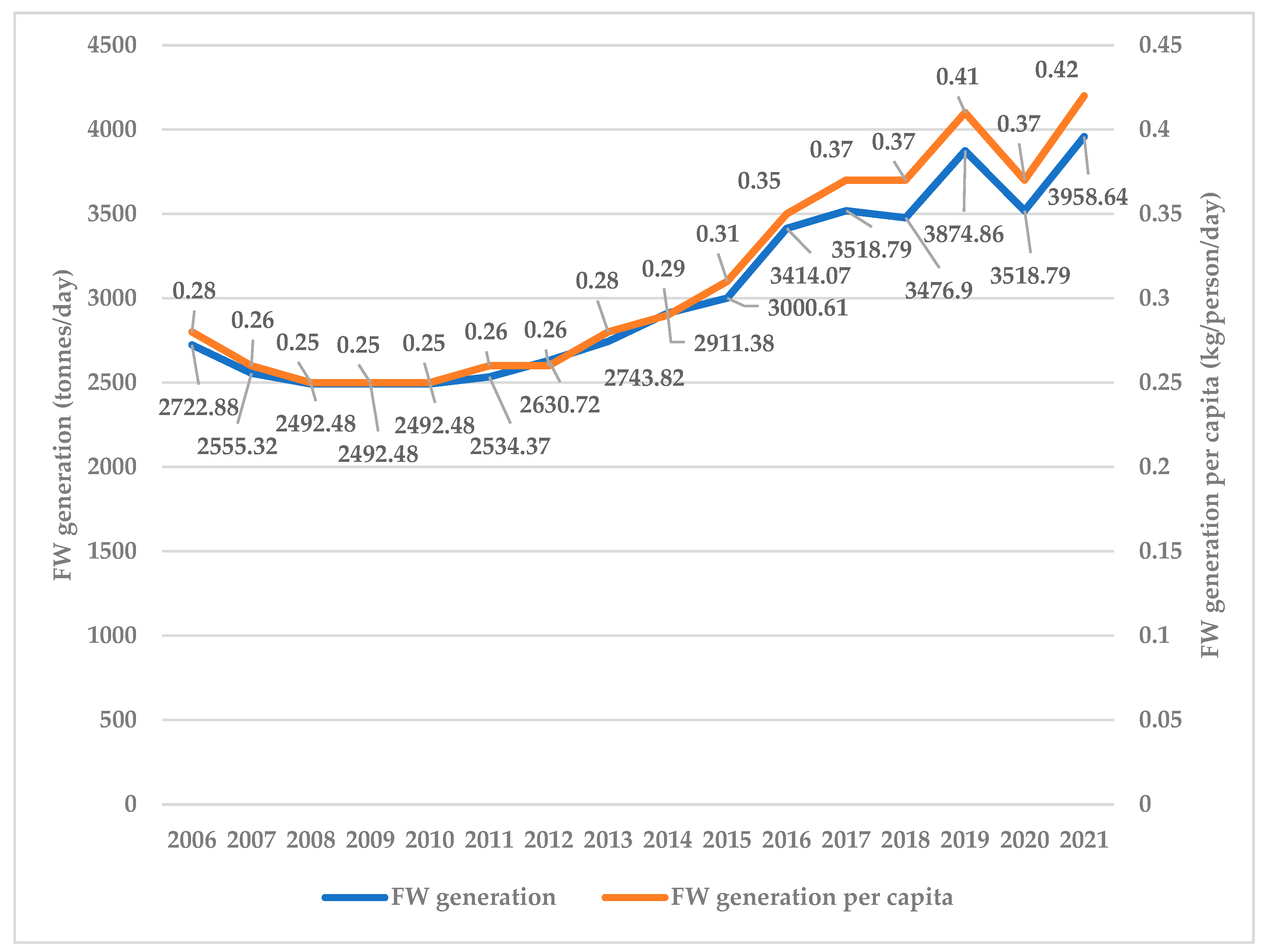
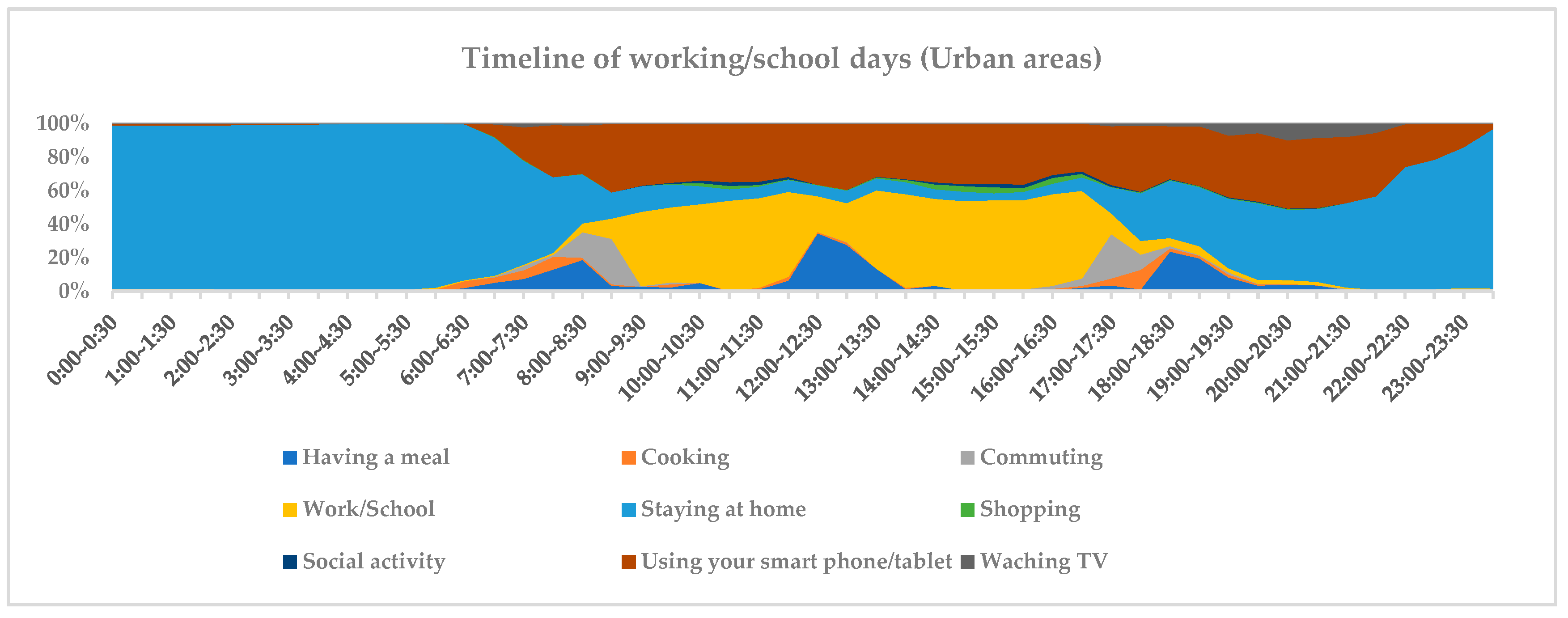
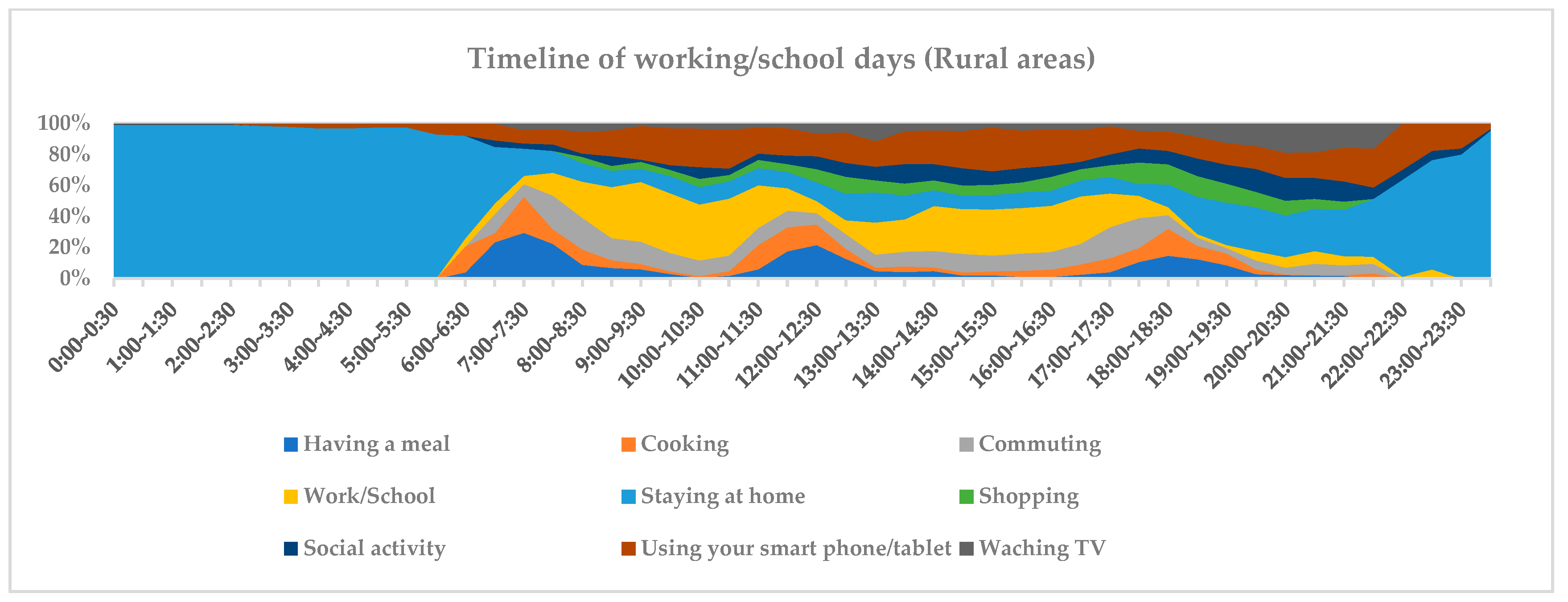
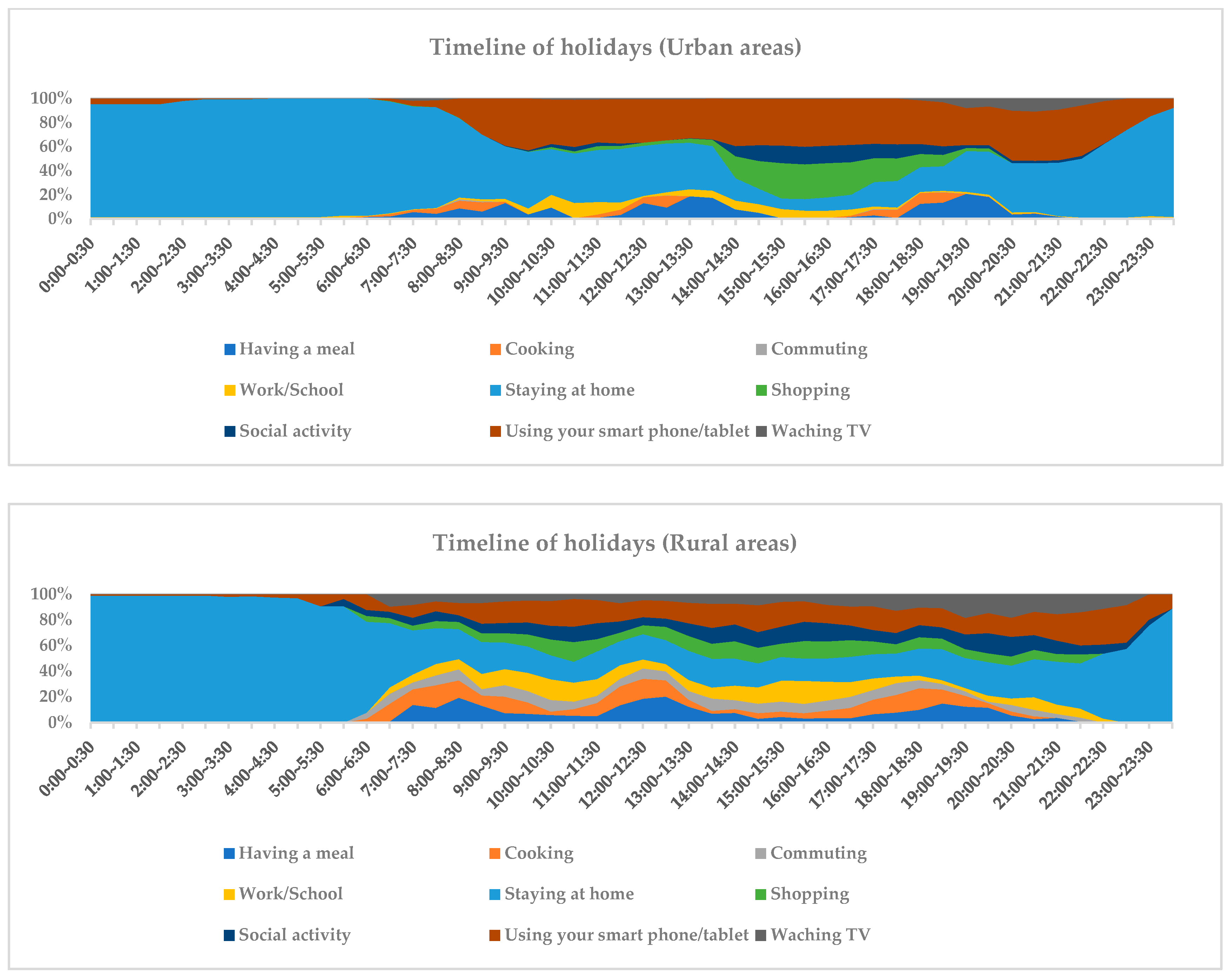
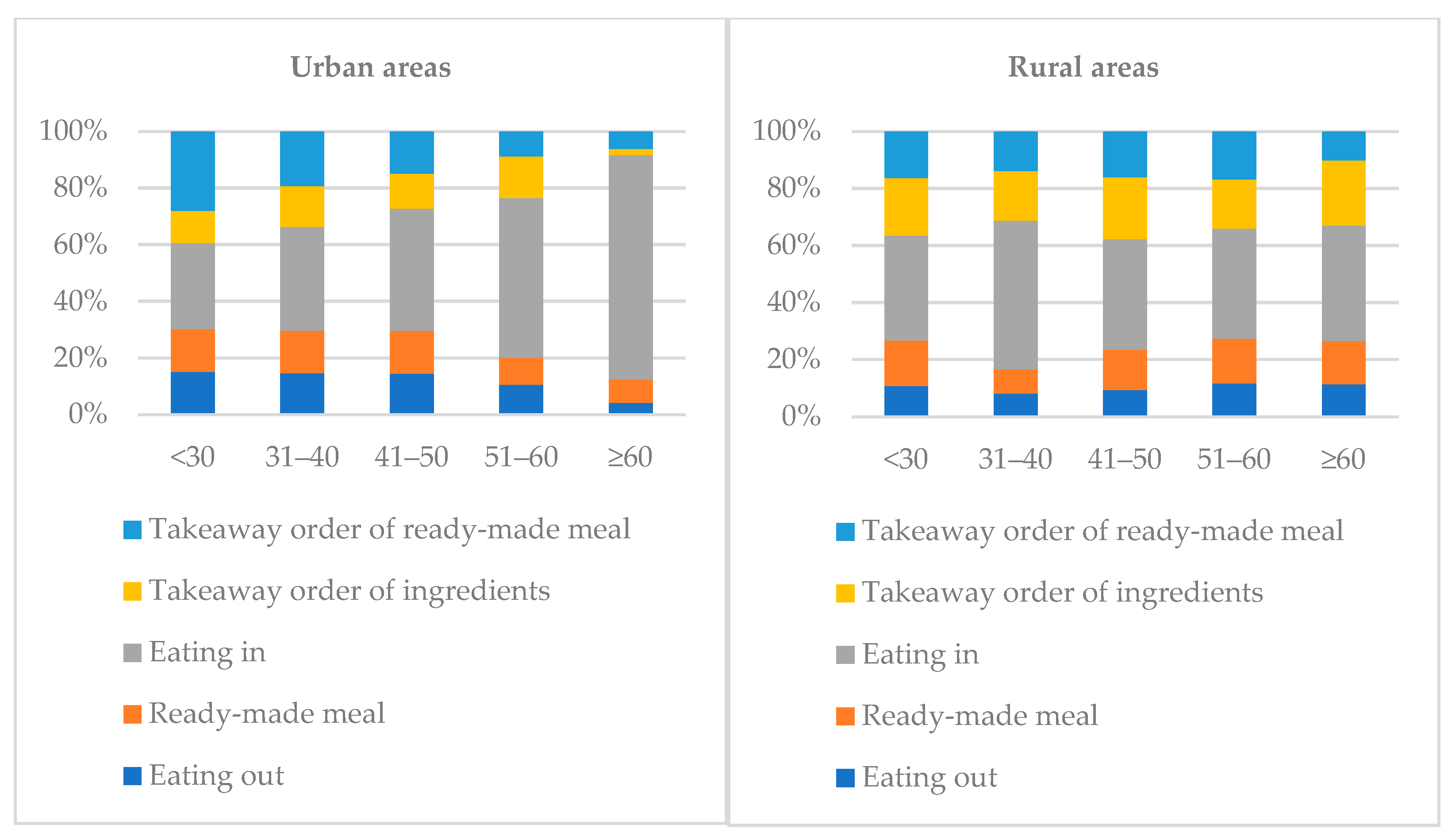
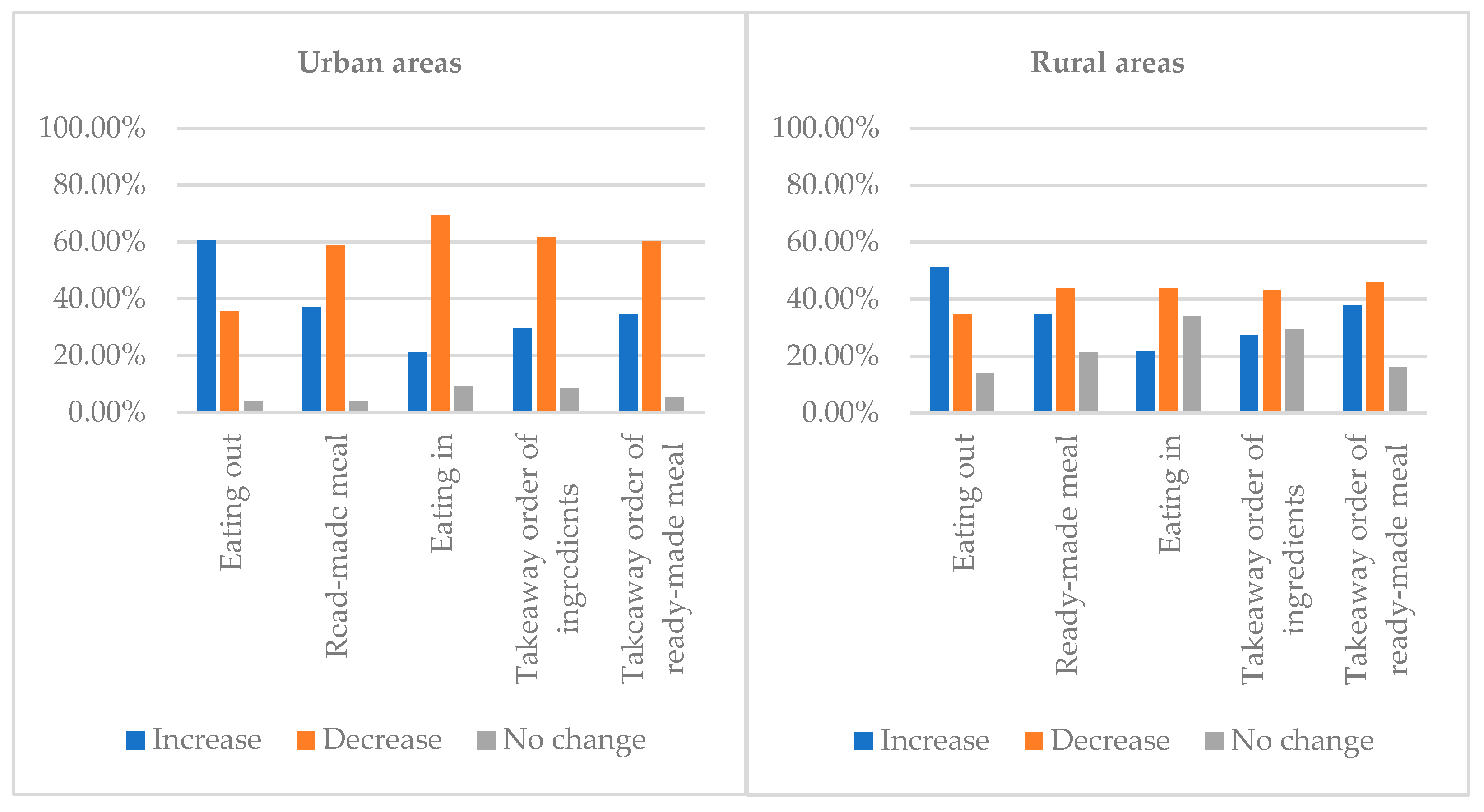
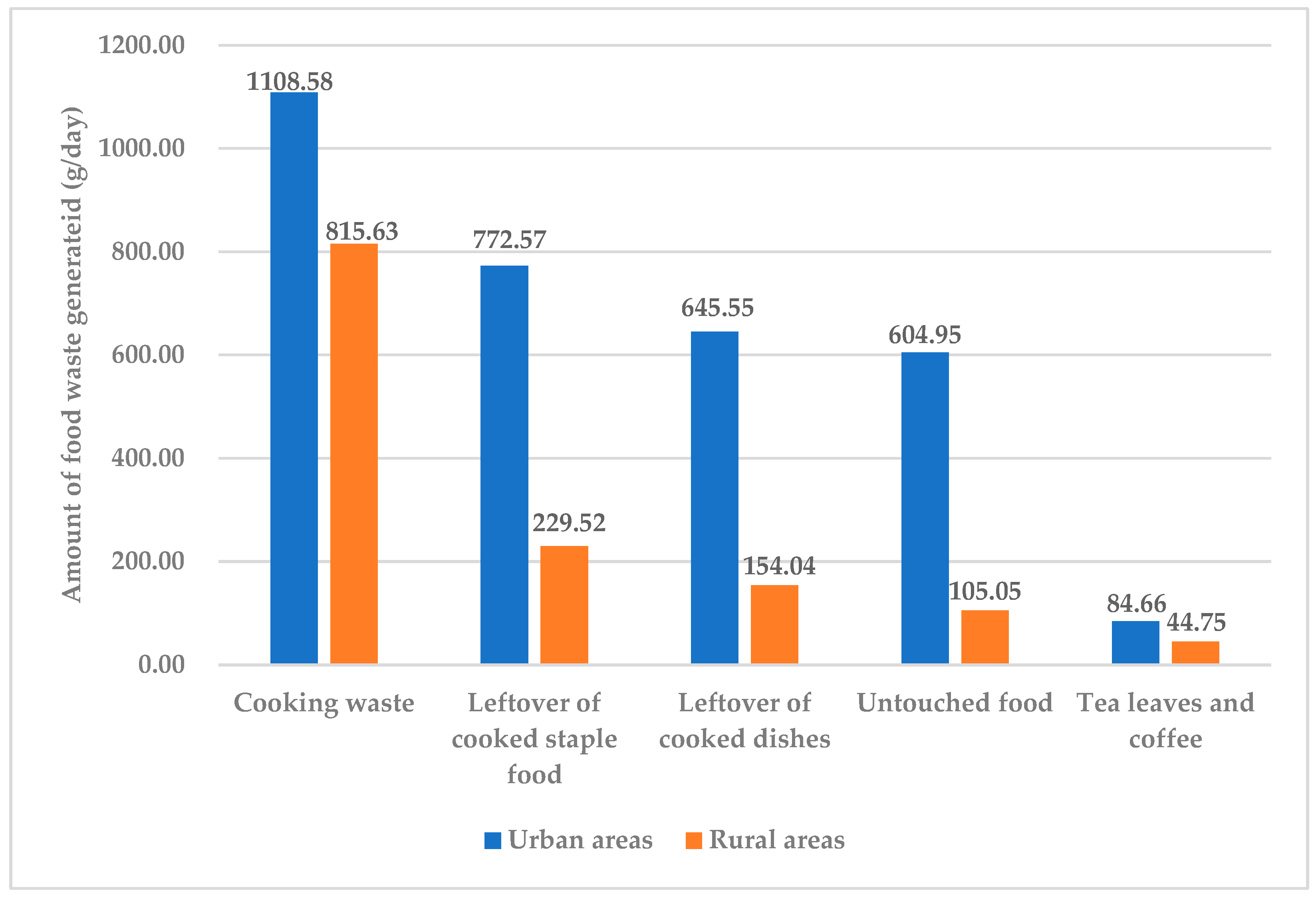
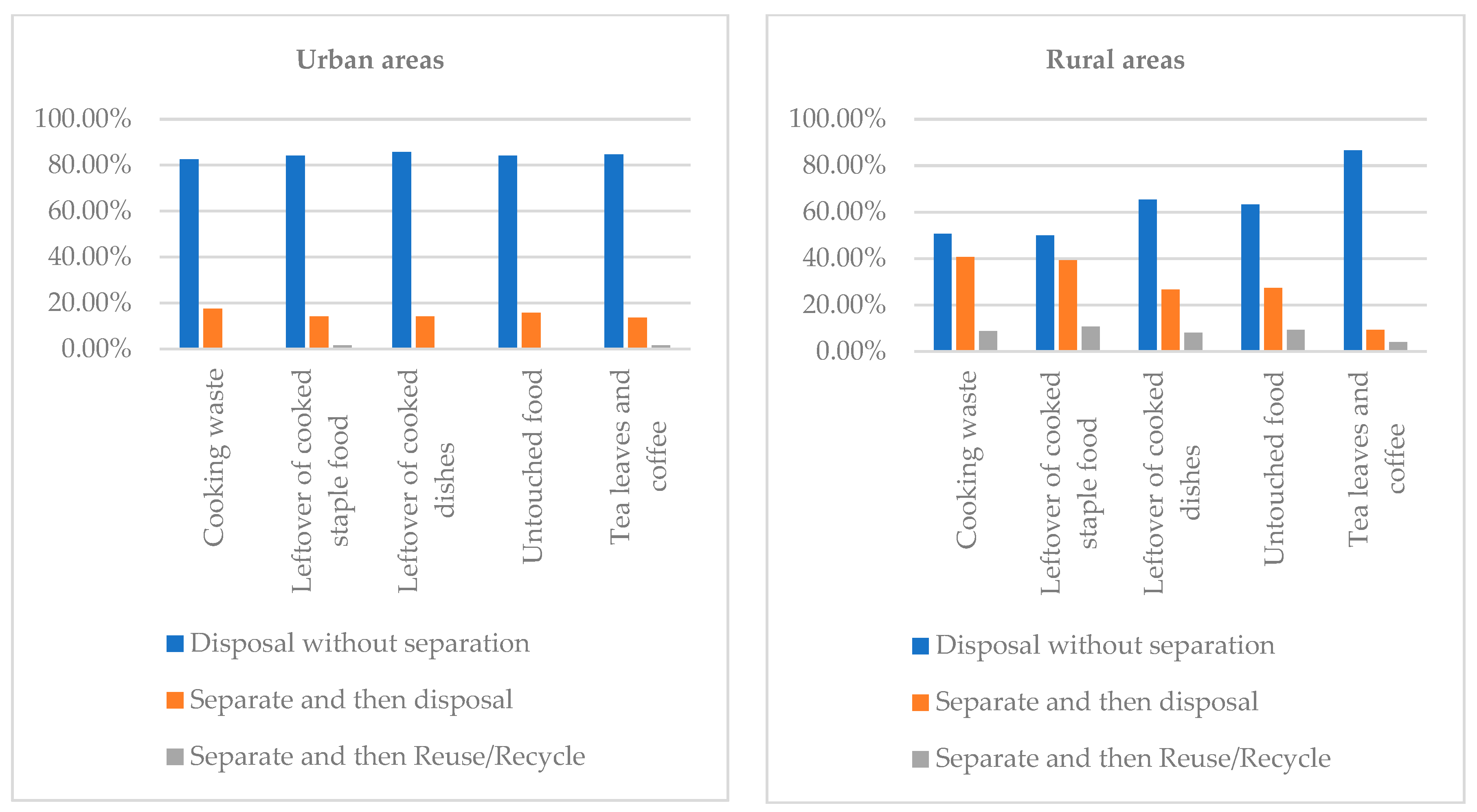
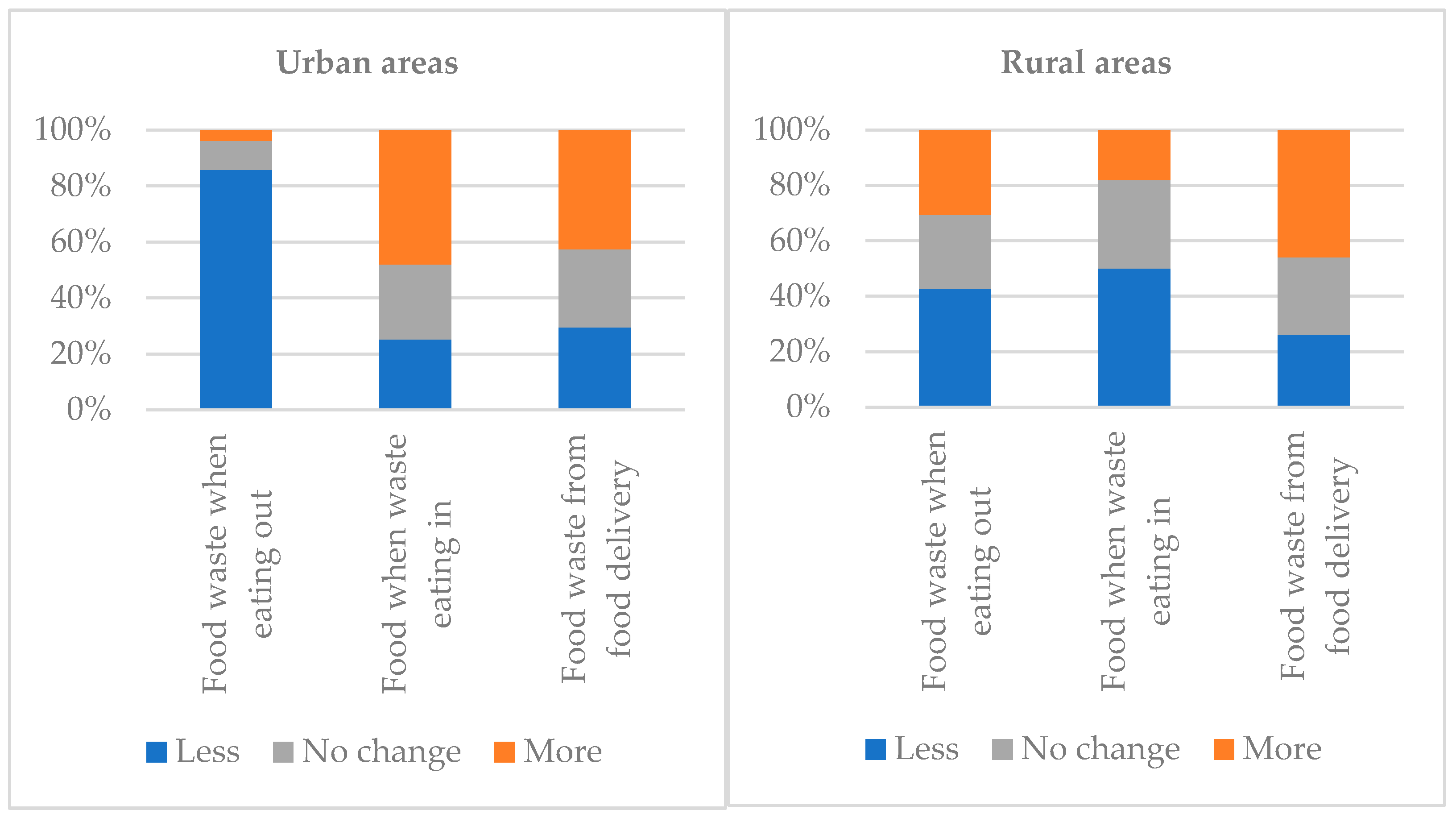
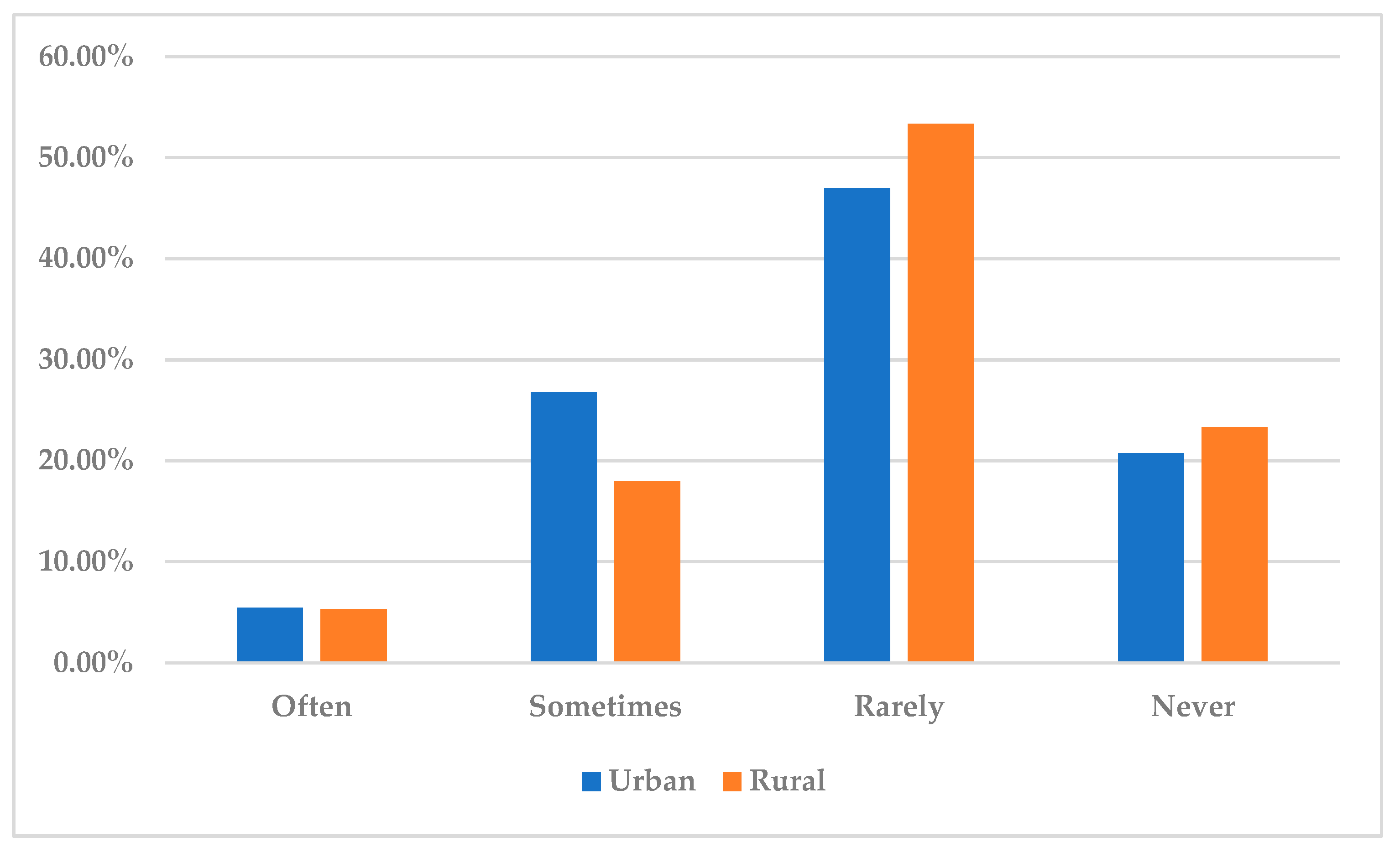
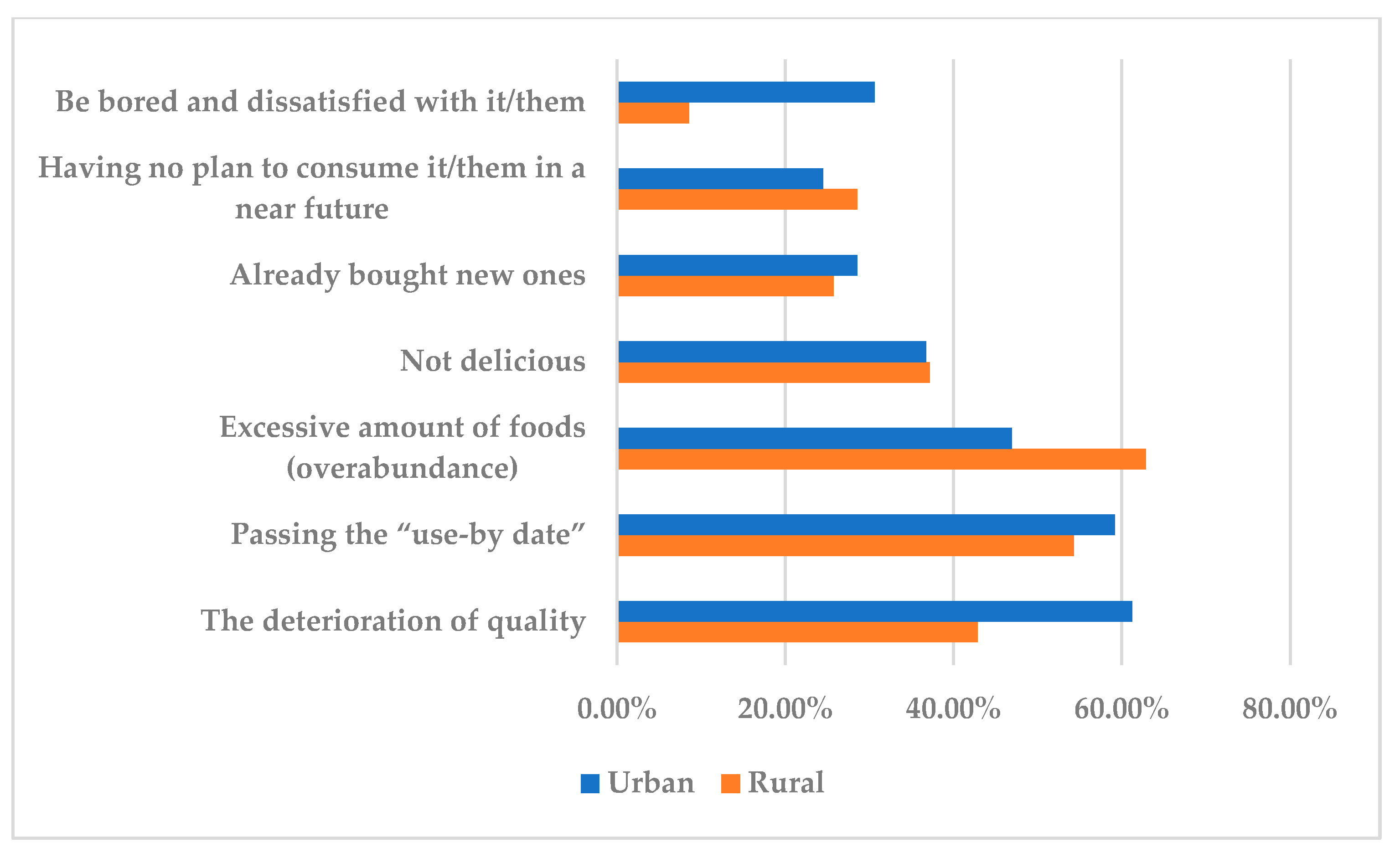
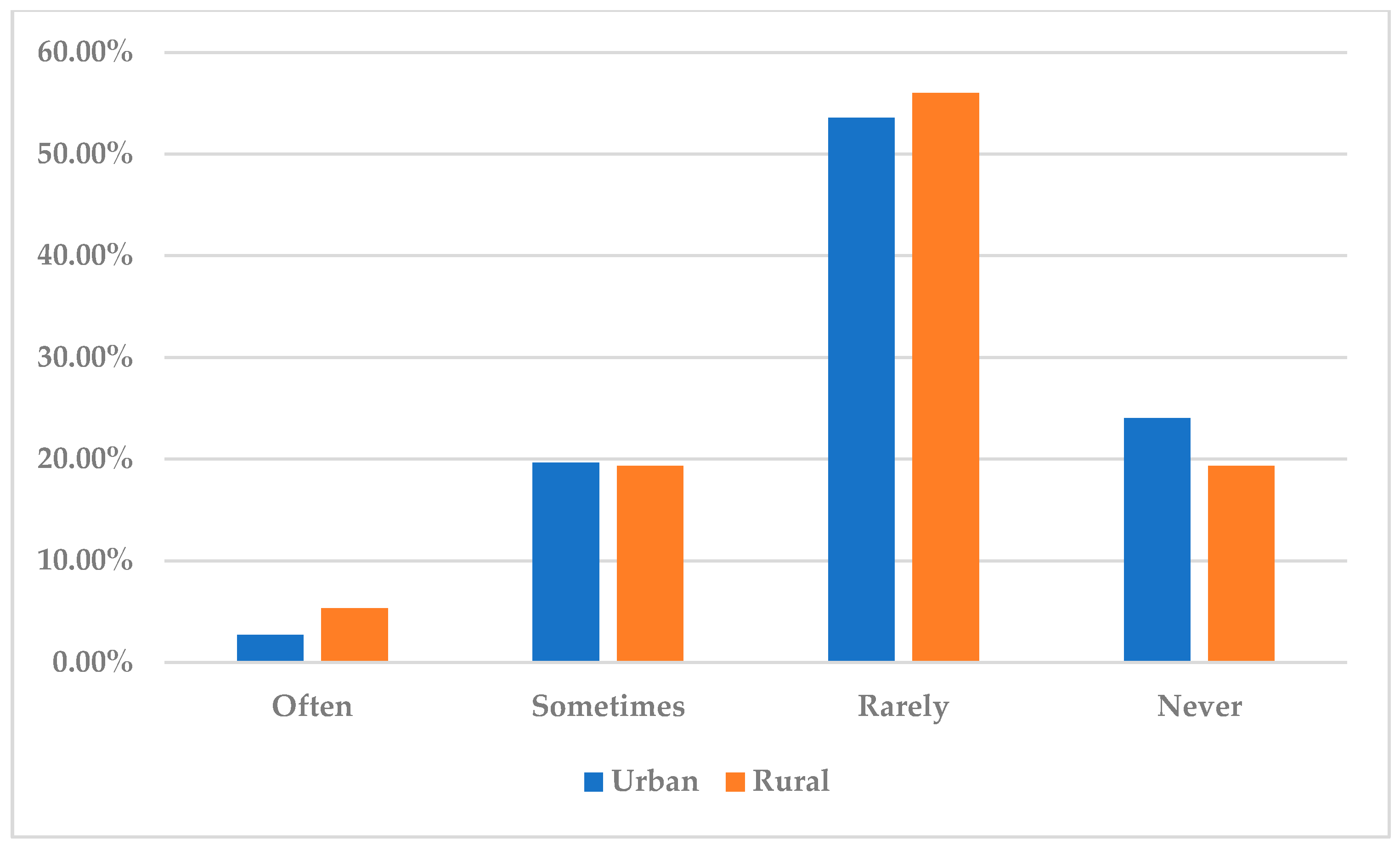
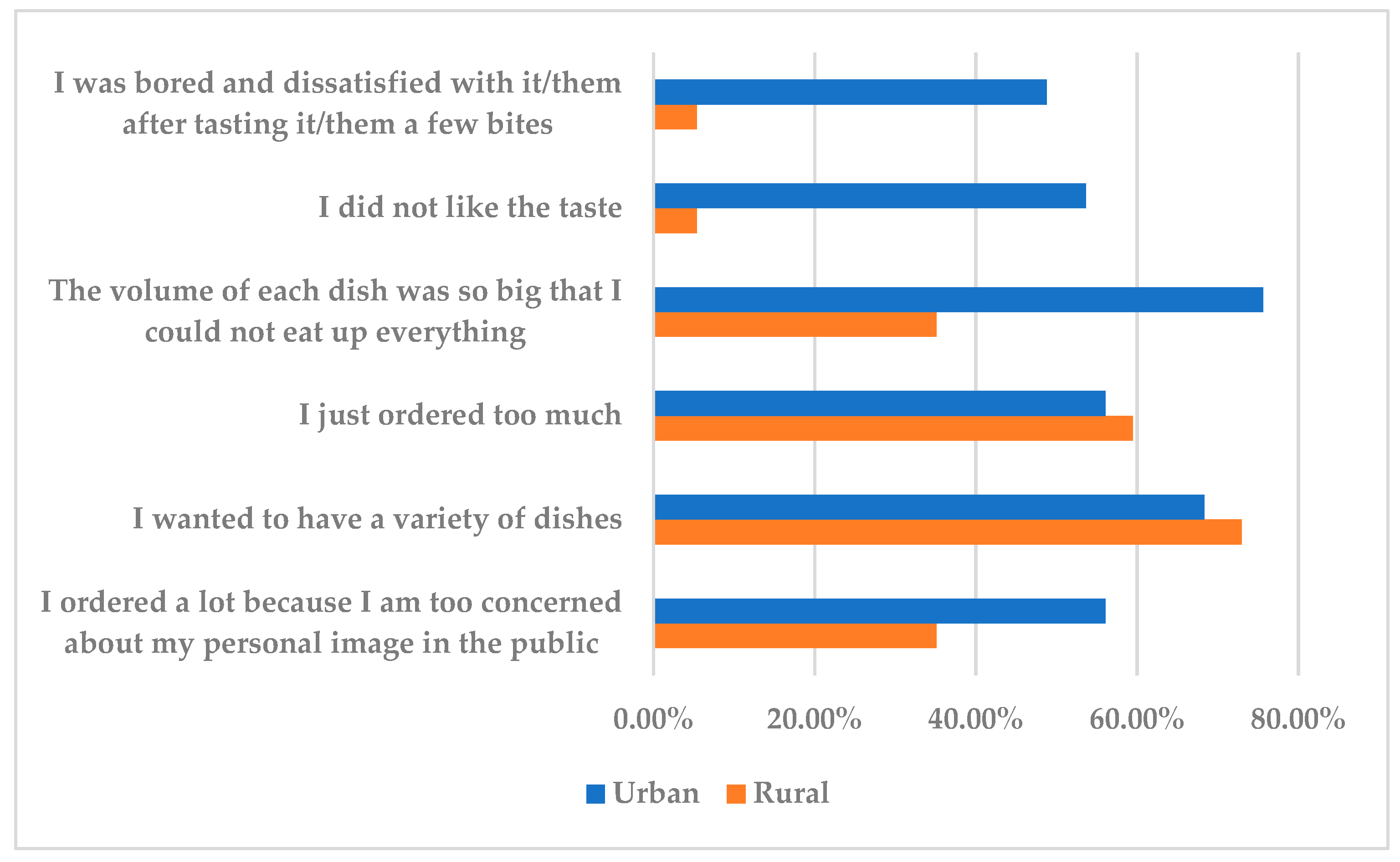
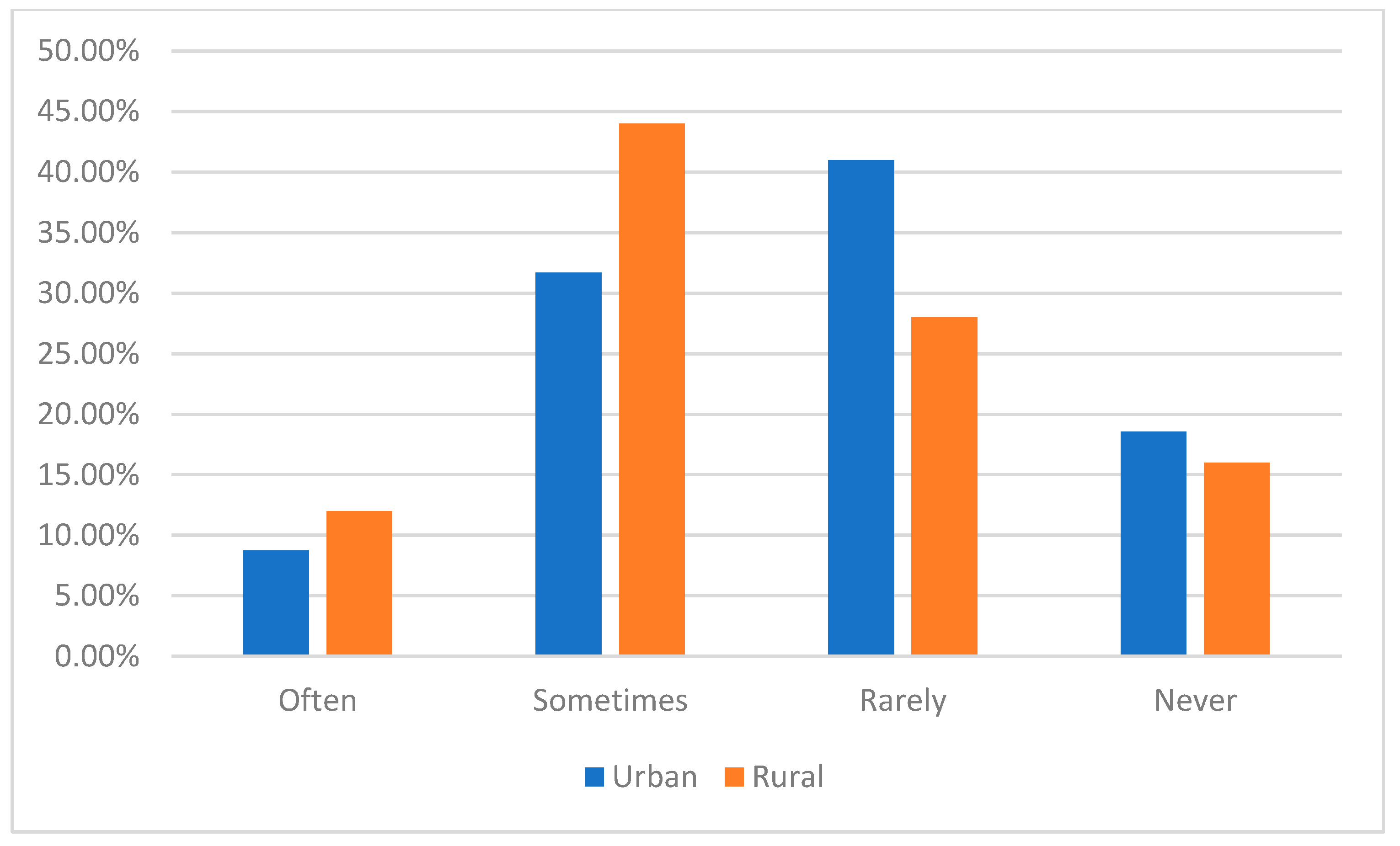
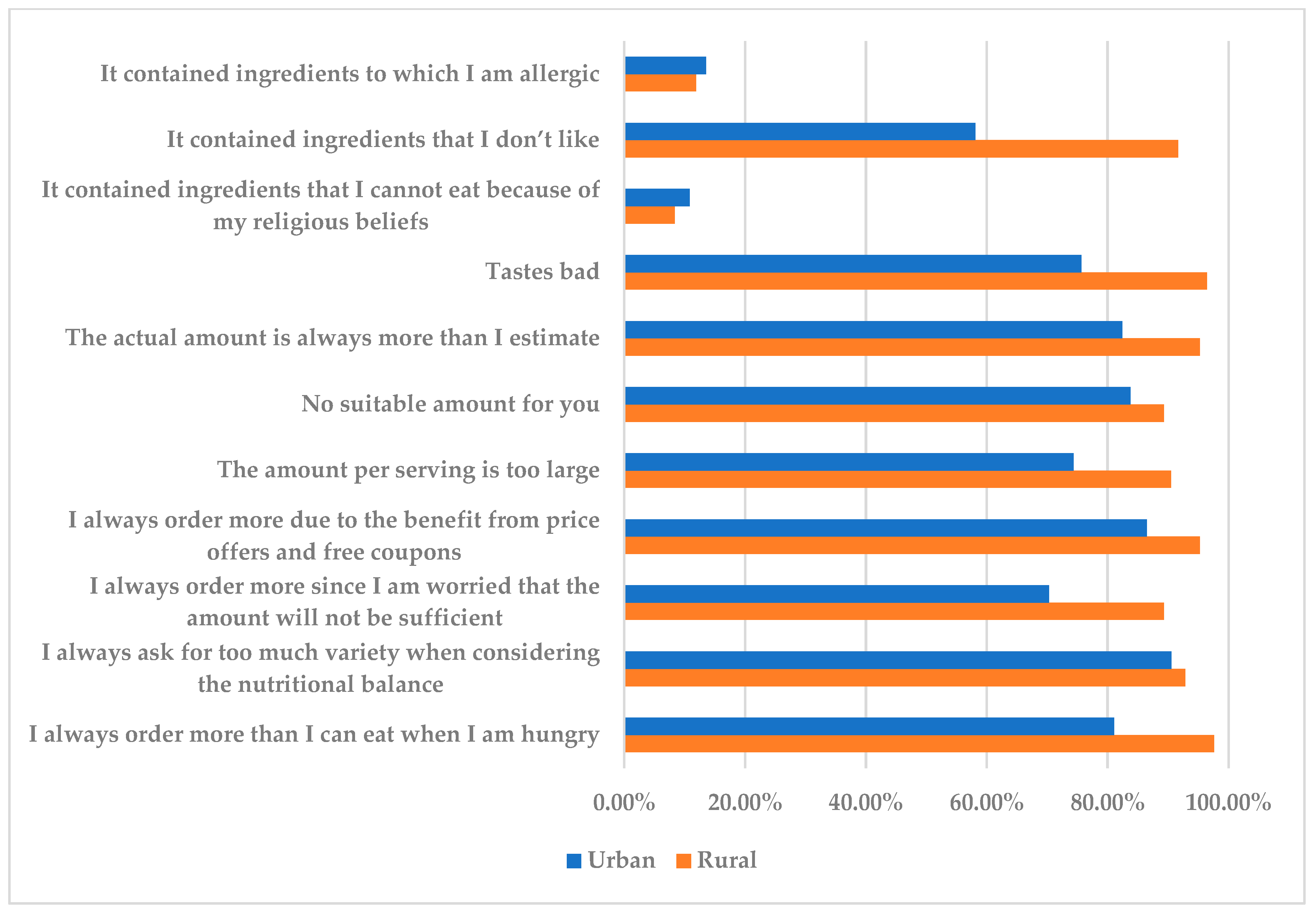
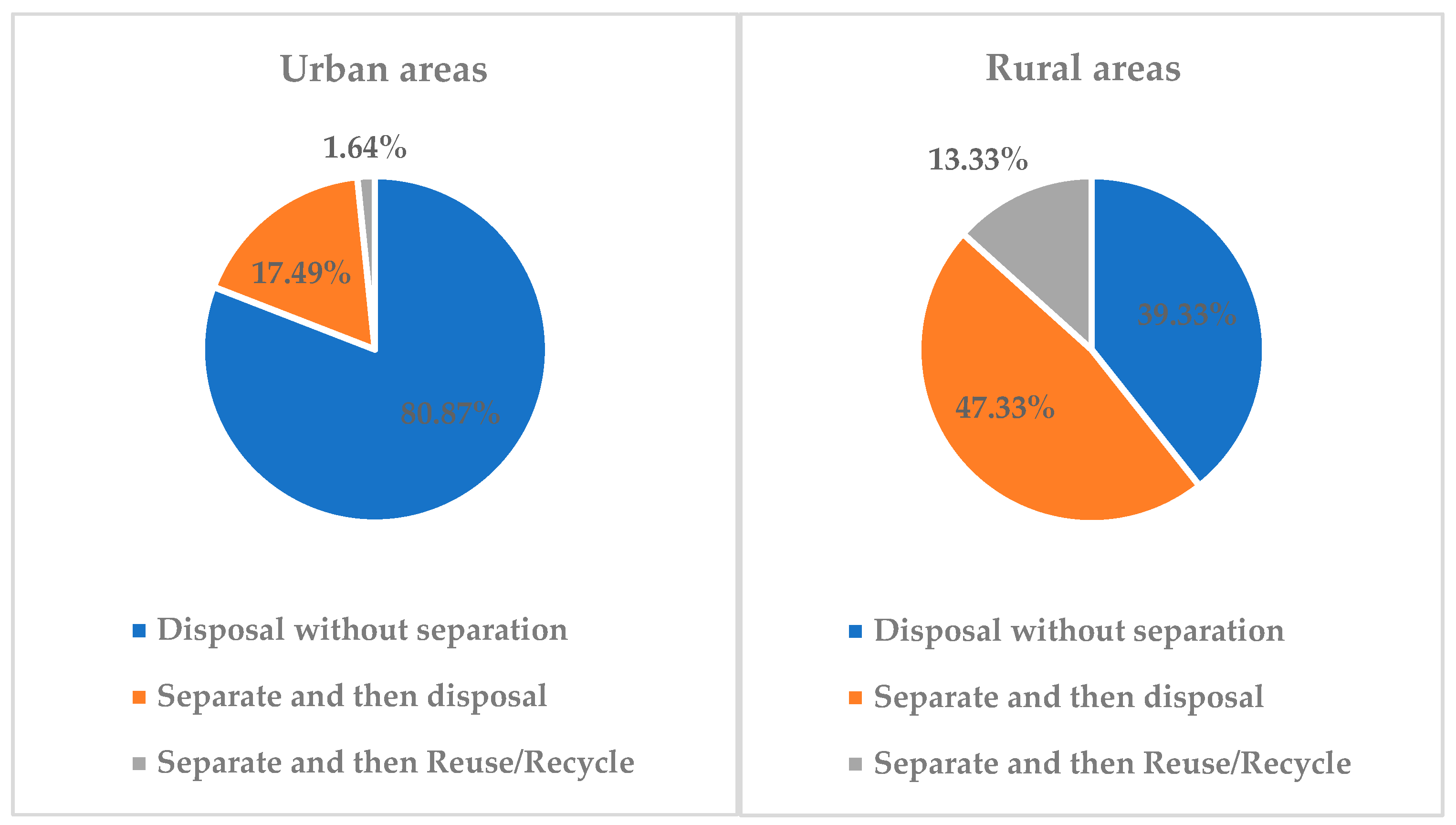
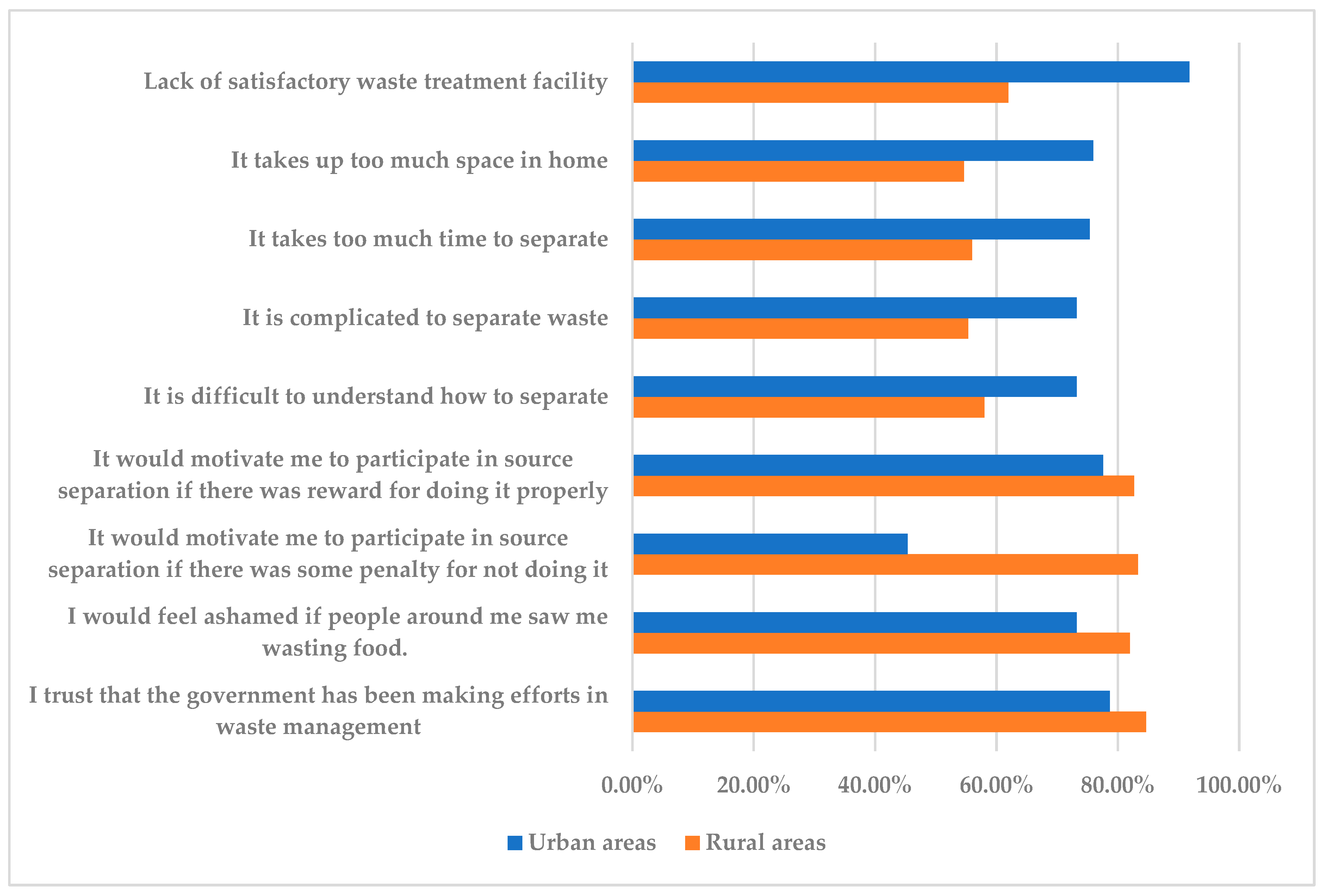

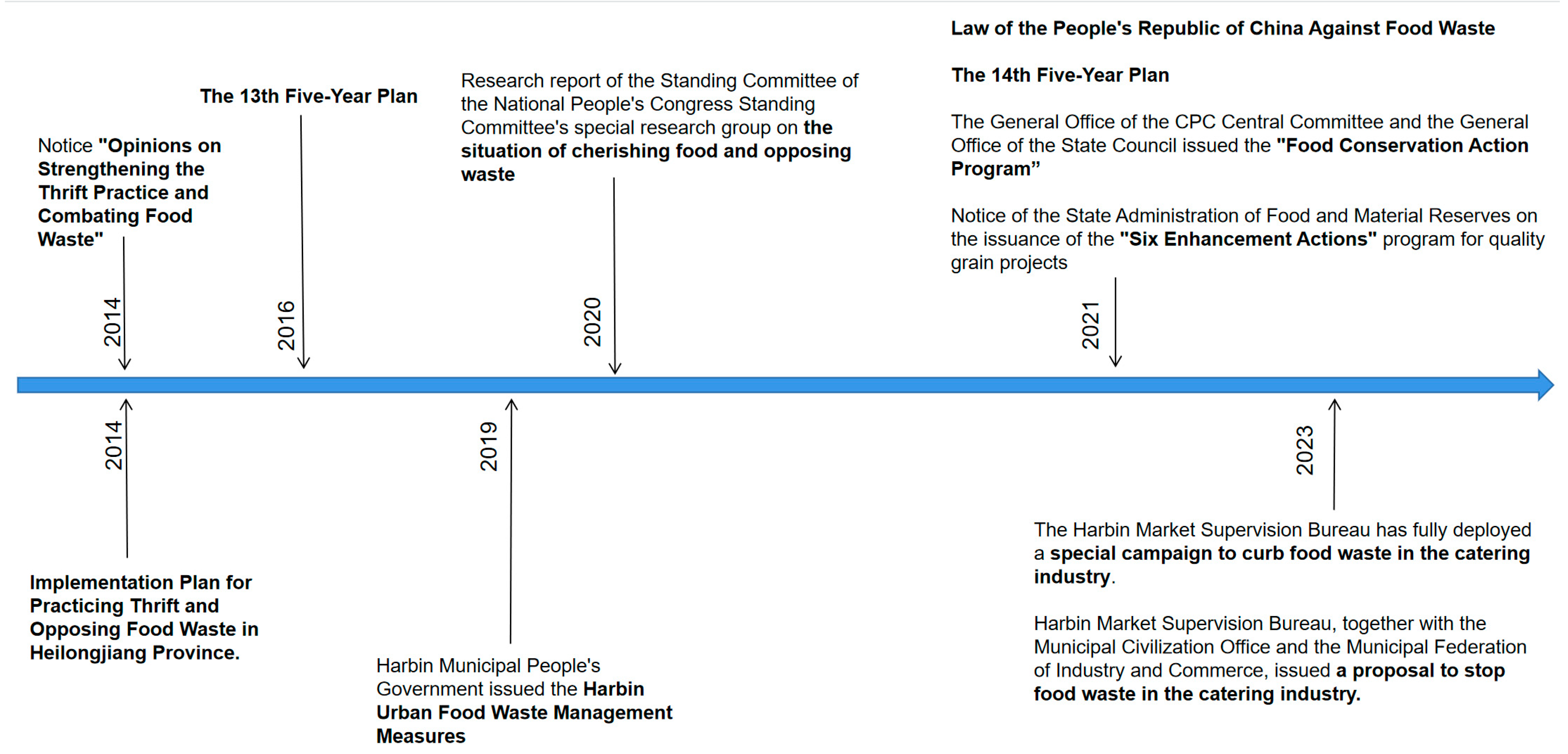
| Number | Region | Number of People |
|---|---|---|
| 1 | Daoli District | 30 |
| 2 | Daowai District | 21 |
| 3 | Nangang District | 36 |
| 4 | Xiangfang District | 29 |
| 5 | Pingfang District | 6 |
| 6 | Songbei District | 11 |
| 7 | Hulan District | 20 |
| 8 | Acheng District | 13 |
| 9 | Shuangcheng District | 17 |
| 10 | Bayan Country | 20 |
| 11 | Bin Country | 22 |
| 12 | Wuchang Country | 35 |
| 13 | Mulan Country | 9 |
| 14 | Tonghe Country | 11 |
| 15 | Yilan Country | 13 |
| 16 | Fangzheng Country | 9 |
| 17 | Yanshou Country | 9 |
| 18 | Shangzhi Country | 22 |
| Total | 333 | |
| Variable Name | Variable Definition and Assignment | Mean | Standard Deviation |
|---|---|---|---|
| Food waste (Y) | High frequency = 1, Low frequency = 0 | 0.26 | 0.44 |
| Gender (X1) | Male = 1, Female = 0 | 0.49 | 0.50 |
| Age (X2) | <=30 = 1, 31–40 = 2, 41–50 = 3, 51–60 = 4, >60 = 5 | 2.39 | 2.44 |
| Area (X3) | Urban areas = 1, Rural areas = 0 | 0.55 | 0.50 |
| Education level (X4) | No schooling = 1, Primary school = 2, Middle school = 3, Technical school = 4, High school = 5, Vocational or technical university = 6, University = 7, Master’s degree or higher = 8 | 5.55 | 1.58 |
| Annual household income (X5) | CNY 30,000 and below = 1, CNY 30,001–80,000 = 2, CNY 80,001–150,000 = 3, CNY 150,001–300,000 = 4, CNY 300,001–1 million = 5, More than CNY 1 million = 6 | 3.23 | 1.14 |
| Characteristics | Urban Areas | Rural Areas | Total | |||
|---|---|---|---|---|---|---|
| Number of Respondents | Percentage | Number of Respondents | Percentage | Number of Respondents | Percentage | |
| Gender: | ||||||
| 93 | 50.82% | 74 | 49.33% | 167 | 50.15% |
| 90 | 49.18% | 76 | 50.67% | 166 | 49.85% |
| Age: | ||||||
| 42 | 22.95% | 54 | 36.00% | 96 | 28.83% |
| 55 | 30.05% | 59 | 39.33% | 114 | 34.23% |
| 52 | 28.42% | 17 | 11.33% | 69 | 20.72% |
| 29 | 15.85% | 14 | 9.33% | 43 | 12.91% |
| 5 | 2.73% | 6 | 4.00% | 11 | 3.3% |
| Occupation | ||||||
| 15 | 8.20% | 11 | 7.33% | 26 | 7.81% |
| 36 | 19.67% | 15 | 10.00% | 51 | 15.32% |
| 41 | 22.40% | 7 | 4.67% | 48 | 14.41% |
| 24 | 13.11% | 11 | 7.33% | 35 | 10.51% |
| 25 | 13.66% | 8 | 5.33% | 33 | 9.9% |
| 16 | 8.74% | 2 | 1.33% | 18 | 5.41% |
| 0 | 0.00% | 75 | 50.00% | 75 | 22.52% |
| 5 | 2.73% | 2 | 1.33% | 7 | 2.1% |
| 8 | 4.37% | 7 | 4.67% | 15 | 4.5% |
| 5 | 2.73% | 9 | 6.00% | 14 | 4.2% |
| 8 | 4.37% | 3 | 2.00% | 11 | 3.3% |
| Education | ||||||
| 0 | 0 | 0 | 0 | 0 | 0 |
| 0 | 0 | 5 | 3.33% | 5 | 1.50% |
| 7 | 3.83% | 28 | 18.67% | 35 | 10.51% |
| 25 | 13.66% | 32 | 21.33% | 57 | 17.12% |
| 28 | 15.30% | 33 | 22.00% | 61 | 18.32% |
| 47 | 25.68% | 29 | 19.33% | 76 | 22.82% |
| 41 | 22.40% | 20 | 13.33% | 61 | 18.32% |
| 35 | 19.13% | 3 | 2.00% | 38 | 11.41% |
| Annual household income | ||||||
| 2 | 1.09% | 9 | 6.00% | 11 | 3.30% |
| 59 | 32.24% | 55 | 36.67% | 114 | 34.23% |
| 57 | 31.15% | 44 | 29.33% | 101 | 30.33% |
| 29 | 15.85% | 22 | 14.67% | 51 | 15.32% |
| 30 | 16.39% | 15 | 10% | 45 | 13.51% |
| 6 | 3.28% | 5 | 3.33% | 11 | 3.30% |
| Odds Ratio | Standard Error | z | P > |z| | (95% Conf. Interval) | ||
|---|---|---|---|---|---|---|
| X1 | 1.891 | 0.498 | 2.42 | 0.016 * | 1.128 | 3.170 |
| X2 | 1.025 | 0.055 | 0.46 | 0.645 | 0.922 | 1.139 |
| X3 | 0.866 | 0.246 | −0.51 | 0.613 | 0.500 | 1.513 |
| X4 | 1.233 | 0.113 | 2.27 | 0.023 * | 1.029 | 1.477 |
| X5 | 1.370 | 0.156 | 2.77 | 0.006 ** | 1.096 | 1.712 |
| Eating Preference (Times/Week) | Urban Areas | Rural Areas | Total |
|---|---|---|---|
| Eating out | 1.83 | 1.27 | 1.58 |
| Ready-made meals | 1.85 | 1.67 | 1.77 |
| Eating in | 5.23 | 5.58 | 5.39 |
| Takeaway order of ingredients | 1.68 | 2.47 | 2.04 |
| Takeaway order of ready-made meals | 2.41 | 1.25 | 1.89 |
| Eating Preference | Pr(|T| > |t|) |
|---|---|
| Eating out | 0.0007 ** |
| Ready-made meals | 0.2833 |
| Eating in | 0.1372 |
| Takeaway order of ingredients | 0.0002 ** |
| Takeaway order of ready-made meals | 0.2084 |
| Eating Preference | Urban Areas (Prob > F) | Rural Areas (Prob > F) |
|---|---|---|
| Eating out | 0.0002 ** | 0.2834 |
| Ready-made meals | 0.0002 ** | 0.0067 ** |
| Eating in | 0.2037 | 0.0772 |
| Takeaway order of ingredients | 0.0009 ** | 0.4244 |
| Takeaway order of ready-made meals | 0.0000 ** | 0.2607 |
Disclaimer/Publisher’s Note: The statements, opinions and data contained in all publications are solely those of the individual author(s) and contributor(s) and not of MDPI and/or the editor(s). MDPI and/or the editor(s) disclaim responsibility for any injury to people or property resulting from any ideas, methods, instructions or products referred to in the content. |
© 2023 by the authors. Licensee MDPI, Basel, Switzerland. This article is an open access article distributed under the terms and conditions of the Creative Commons Attribution (CC BY) license (https://creativecommons.org/licenses/by/4.0/).
Share and Cite
Liu, C.; Shang, J.; Liu, C.; Wang, H.; Wang, S. Policy Recommendations for Reducing Food Waste: An Analysis Based on a Survey of Urban and Rural Household Food Waste in Harbin, China. Sustainability 2023, 15, 11122. https://doi.org/10.3390/su151411122
Liu C, Shang J, Liu C, Wang H, Wang S. Policy Recommendations for Reducing Food Waste: An Analysis Based on a Survey of Urban and Rural Household Food Waste in Harbin, China. Sustainability. 2023; 15(14):11122. https://doi.org/10.3390/su151411122
Chicago/Turabian StyleLiu, Chang, Jie Shang, Chen Liu, Hui Wang, and Shuya Wang. 2023. "Policy Recommendations for Reducing Food Waste: An Analysis Based on a Survey of Urban and Rural Household Food Waste in Harbin, China" Sustainability 15, no. 14: 11122. https://doi.org/10.3390/su151411122
APA StyleLiu, C., Shang, J., Liu, C., Wang, H., & Wang, S. (2023). Policy Recommendations for Reducing Food Waste: An Analysis Based on a Survey of Urban and Rural Household Food Waste in Harbin, China. Sustainability, 15(14), 11122. https://doi.org/10.3390/su151411122











